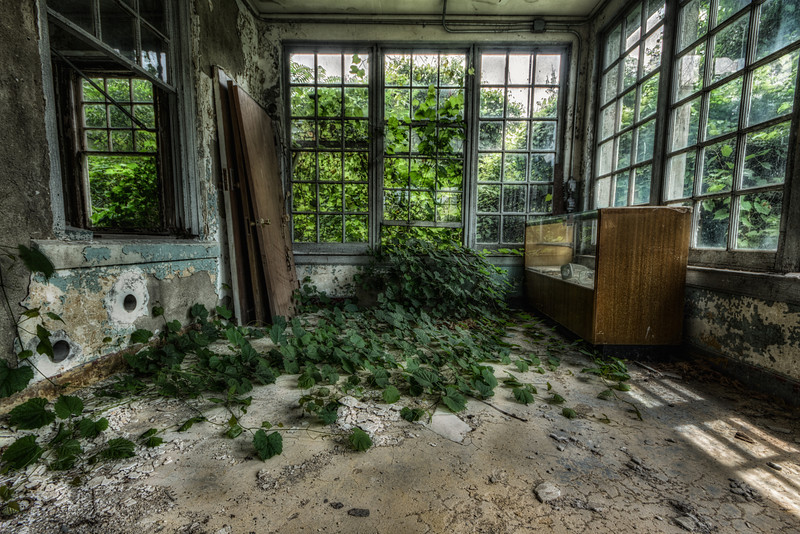ANGELICA

My friend Andy had invited me along on his second shoot to the old Allegeny County Home in Angelica, NY after he and his friend Walt visited there about two months prior to my trip. I have always been fascinated with the history of institutions, asylums and hospitals and this was an opportunity for me to visit another relic of the past that has had quite a unique and somewhat disturbing past as most of these once common county homes, almshouses or lunatic asylums have. The county home in Angelica has quite a history and much of it that I will share has been researched over the internet and historical documents. The original poor house was erected in 1831 and had been rebuilt and added on over the years most notably after a major fire in 1923. It certainly wasn’t the creepiest placed I’ve had the opportunity to photograph, but it most definately was quite interesting. The entire structure was set up like an “H” with two long wings with a connecting hallway between. Probably the coolest area in the entire place was the room of a million newspapers and a single rocking chair as if someone spent their entire life searching for something newsworthy, hopefull or real.


Excerpts taken from Allegany County, New York Gen Web site:
In the 1820s, the committee on the poorhouse suggested that there be no distinction between the county and town poor. Allegany county appointed superintendents to the poor who were instructed to buy a farm and to build buildings to house the poor. Mssrs. Van Nostrand, Huff, Lockhart, Gordon and Merrick were apponited to make the nominations for superintendents. These were elected supervisors of the Poor: S. S. Haight (Angelica), Lorenzo Dana (Friendship), Andrew C. Hull (Birdsall), Stephen Major (Almond) and William P. Wilcox (Nunda). A stone building was erected on an 180 acre farm about two miles east of the county courthouse. In 1860, J.H. French noted that it housed an average of 57, inmates, but that the building did not have any means of ventilation. At that time the farm was yeilding about $1,000/year.

Considered the “most horrible event in the history of Allegany County,” the Allegany County Alms House at Angelica burned down 90 years ago with seven aged women and one man trapped in the burning buildings and perishing in the flames. The nightfireman was still unaccounted for three days later.
A little before midnight on March 15, 1923 fire was discovered in the boiler room in the basement of the administration building, above which were the inmates’ dining rooms and kitchen, and the second floor above, the employees’ sleeping quarters. Connected to this by a 50-foot passageway was the women’s dormitory with seven bedridden patients and 14 other inmates plus two babies, one about one year old, and one, three months old.
In front was the dwelling, of the Superintendent Mr. Hall, his wife and two sons, aged 8 and 5. The men’s concrete dormitory housing 29 inmates, was in back. Following the discovery of the fire, immediately there was an explosion in the passageway which quickly spread the flames to the women’s dormitory and the superintendent’s house, and all three buildings were quickly wrapped in flames. Employees started jumping from upstairs windows; one jumped from his window, grabbed an electric wire and slid to the ground; Another followed and Hall and his family were roused from their rooms. They immediately aroused the men and women inmates, and the 29 men with their attendant marched out.
The fourteen women and two babies were removed from the burning building by the concerted efforts of the employees and Mr. and Mrs. Hall, but the seven bedridden patients were not so lucky. Mrs. Dornow of Scio, jumped from the upstairs window and was severely injured. Because she was a large woman, Mrs. Hall was unable to lift her to carry her away from the heat of the burning building and had to roll her over and over.
In a very short time all three buildings were burned to the ground. The only things saved by any inmate, employee, or Hall and his family were the nightclothes they were wearing. They all agreed however that, had it not been forMr. Stafford, an employee who was visiting with Miss Jennings, the inmate’s cook, who discovered the fire in the boiler room, they too, would probably have been burned to death.
Volunteer fire companies came from Angelica, having made the three mile-run from the town with their hose carts and truck, only to find that their services proved of little value. The pipe through which part of the Alms House water supply came was from a deep well but the pump and heavy pressure air tanks were located in the basement near the boilers and shortly after the firemen arrived, they were out of commission. Through their efforts however, the fire was kept from the stables and the other buildings.

The men’s building, the only dwelling to escape destruction, was immediately equipped for the emergency and had since the fire housed some of the staff and inmates.
Plans for fireproof structures to replace those that were destroyed, were drawn, and were approved by the State Board of Charities. The work preliminary to the laying of the foundations has been started. The farm buildings escaped damage, and farm work continued without check. One barn had been reshingled, and another was to be. The dairy herd received a final tuberculin test, as the survivors were free from infection at the time.
New equipment included tableware, clothing, washing machine, refrigerator, tables, chairs, gas heaters and lights, and (ordered) a combination range to replace gas plates; there were also a new Register and State Board of Inmates.



Wards and Rooms
- First floor, women’s ward- 5 beds, 4 occupants
- Second floor, men’s ward-5 beds, 5 occupants
- Second floor, men’s room- 1 bed, 1 occupant
- Second floor, men’s room-1 bed, 1 occupant
At the time of the fire there were 56 inmates, of whom seven were burned to death. Two employees were also lost in the fire. Since the last general inspection there had been 20 admissions, 49 discharges, and 14 deaths, including those burned. All but two of the eleven inmates remained in good health.
Lavatory, toilet and bathing facilities were adequate, convenient and modern. A laundry machine was provided; the men’s things were sent to a laundry. Working equipment, including a temporary kitchen and dining room, was in the basement. A large refrigerating room had also been built there.


- Superintendent, William H. Hall – Salary $1,500
- Matron, Mrs. Hall – $600
- Foreman, Paul Weinhauer – $70 per month.
- Farmhand, Leon Weir – $45 a month.
- Farmhand, Reuben Harding – $45 a month.
The attending physician, Dr. B. C. Wakely, of Angelica, would visit only on call, and his visits were not recorded at the Home, as they should have been. This criticism had been repeated for several years. The matron performed the cooking for inmates and staff. The inmates receive the same food as the staff except as to desserts. Meals for inmates on a typical day of inspection included: Breakfast – Rolled oats, milk, sugar, warmed-up potato, bread, butter, fried bacon, coffee, tea. One man in bed had fried eggs.
Dinner- Boiled potato, beef gravy, summer squash, cucumbers, bread, butter, tea.
Supper- Creamed potato, bread, butter, tea.
Meat and eggs for breakfast were unusual; this meal was otherwise the same every day except that cookies were added occasionally. Suppers included potato or soup, and sometimes leftovers. Butter was provided twice a day. Dinners included one or two extra vegetables in season, and fresh meat twice a week. Berries and applesauce were served frequently. Friday’s dinner consisted of warmed-over beef, boiled rice, boiled potato, gravy, cucumbers, beet pickles, bread, tea, and milk.
Butter was not made there, as the cream was shipped in. Four more cows had been lost following the tuberculin tests, making 29 lost in all. There were now 10 cows, 7 heifers, 2 heifer calves and a bull, all purebred Jerseys following the devastation.


Front and rear stairways in the newer main building provided alternate means of egress in case of fire. The main sitting room was used by the inmates in winter. Bathrooms were adequate; there is a separate one for women. The building had no furnace, but it contained two big stoves, a smaller one, a gas range, three gas heaters and one electric heater. There was one stove in the annex. Beds were fairly comfortable, and bedding was adequate.
This place was managed by Mrs. MacConnel, a trained nurse, and she employed a practical nurse who had 18 months training, also two other helpers. The county paid $5 a week per capita. Among the inmates were one young epileptic, who was to be transferred to Sonyea. The young mother was 24years old. All the other inmates were over 70, and two were 93. Four were blind, two had weak hearts, and two had kidney trouble. Those needing special care remained in the main building.


Most of the above building information, staffing and patient information was taken from an April 1973 clipping from the Angelica – County Home Spectator, the Allegany County, NY Gen Web site as well as excerpts found in county books from the Hinkle Library at Alfred State College (1923).
I like to share as much information and history on a location if and whenever possible to give the viewer a clearer picture of the site while viewing my photographs. The day of this particular shoot was sunny and it was a comfortable nearly three hour drive. Andy had shared with me his experience with being there only a few months prior. I had seen some of his amazing photographs, and while plotting our next photo adventure, he thought it might be cool to go back to photograph some things he had missed along the way the first time. As I mentioned earlier in this post, one thing that caught my eye was the room literally filled with old news papers, mostly strewn about but some were in binding. Another cool find was the music room in the old poor house. I could only imagine what it must have been like to sit in that room on summer evenings fifty or sixty years ago while tunes played out on the pianos.







Many times these old abandoned places are interesting certainly for their stories of the past, the human experience and suffering and the sense of being transported back in time. However in quite a few locations such as this, relics from the distant as well as not so old past can be found forgotten and left behind including old furniture, clothing, paintings and artwork, medical equipment and more. At times some of these items appear common and at other times we have no clue as to what they are or what their purpose was.



The Allegany County Poor home in Angelica, NY definitely has an interesting and frightening past considering the lives that were lost there through the horrific fire of 1923 as well as all the other souls that just died there of natural causes. Poor houses were a part of American and world history. Many of these places housed not only the poor, but the unwanted, the undesirables, the outcasts and the mentally handicapped. Places such as the Allegany County Home are becoming a forgotten part of our history. Many believe that these places and the tragedies that occurred behind these walls should be erased from all record permanently. I however believe that the stories and voices need to be told and the ancient yet decaying beauty of these structures needs to be captured as art. Because as the saying often goes ” They don’t make ’em like that anymore” I hope you enjoyed the story and the photos as well as the last remaining photos following this story. Photos can be purchased directly here or by visiting my archaic art galleries on my website.











[…] Lou’s story and photos from the shoot can be seen here: LouisQPhotography.com […]
[…] Lou’s story and photos from the shoot can be seen here: LouisQPhotography.com […]
Really enjoyed viewing your photos! I would love to go there someday
Love these!!!
I remember the County Home very well. My dad drove us by it many times to visit an aunt and uncle who lived in Angelica. Great coverage, thank you.
I really enjoyed your pictures and the story. I now live next door to the Angelica County Home. I hope to take a tour of the place and see some of the things you saw. Thanks for sharing the story of the County Home
These photos are AWESOME!!! My friend, Cheryl Owen, was the last owner of this place. She bought the property back in the early 1980’s. I wish I would have toured this old building on
the days that I visited her. She had always planned to fix this place up, but never got around to it. She died two years ago of cancer.
Our paranormal team did a investigation there last year.
Colin Stillman
My sister lives in Angelica and her husbands family for years.We just got back from their two weeks ago and wish in all the times we have visited wish i would of known about this place. Beautiful story line and magnificent photography.Iwill go visit this place when i go again next summer.Thank You for the tour and history.Very sad and erie.
Used to work here in the 1970’s when it housed the Allegany County Dept. of Social Services. I recognize some of the rooms but don’t remember the room with a piano. Too bad it has fallen into ruin.
Would love to know who let you in there as we were told that due to safety issues and the poor conditions nobody is allowed in there. …
Looks too far gone now to rehab through historic register? Who owns it now? Have heard stories of patients who died there and buried in a simple cemetery with no markers true?